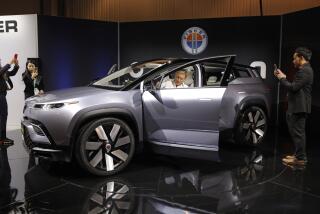2011 Scion tC shifts into gender-neutral
Like the Boy Scouts, the waiting line for a midnight release of Halo or tractor trailer-pulling contests, Scion’s new 2011 tC is pretty much for the guys. Or so the company would have you think.
At the San Diego media launch for the second generation of this coupe, Scion described the styling elements the company aimed for when designing the new tC. Terms like “masculine,” “aggressive” and “bold” were used so often, you’d think they were describing Mr. Olympia driving in a monster-truck rally.
The original Scion tC was the company’s most popular model, selling some 310,000 units over its six-year run. Initially, the gender makeup of buyers skewed more male, yet by the end of its lifespan, more dames than sirs were buying the tC. Offering a model in baby blue (nee Wave Line Pearl) probably didn’t help.
Now Scion wants the boys back.
If you’re just joining us, Scion is a 7-year-old division of Toyota that caters to the youth market. It’s an anti-establishment effort to help this finicky demographic forget about the plebeian Camry and Corolla.
Scion offers compact, economical cars with unique designs and a huge array of customizable features both inside and out. You may scoff at the necessity of a coffee can-sized tailpipe or a carbon-fiber shift knob. However, Scion has gained a remarkably loyal following through its efforts. A well-orchestrated guerrilla marketing campaign has helped.
Given that the tC is aimed at buyers who are more Xbox than Excel spreadsheet, one could reasonably expect an envelope-pushing exterior. Not so. Its short rear overhang skews the car’s proportions and gives it an abrupt rear end.
When viewed from the side, this contrasts with a long hood to give the impression that the coupe (it’s technically a hatchback, but how cool does that sound?) is poised on its haunches, ready to strike. The front of the car is more horizontally oriented than its predecessor, with trapezoid headlights that give it a handsome look.
Overall it’s a conservative look for a youth-oriented car. No doubt a cavalcade of aftermarket body modifications will work hard to alter that image.
The new tC isn’t overtly masculine any more than the first iteration was overtly feminine. To be sure, the new model’s exterior has more edges and creases and a more aggressive stance thanks to a wider track. The effort to man it up a bit is clear. But no one lacking a Y chromosome will feel uncomfortable owning this car.
Regardless of gender, tC buyers get a lot for their money. The base price is $18,995 (including destination charges) and includes a laundry list of features young buyers hold dear but any driver can appreciate.
Among the standard amenities is a six-speed manual transmission; 18-inch alloy wheels; panoramic moon roof; a 300-watt Pioneer sound system with amplifier, eight speakers, auxiliary and USB inputs and steering wheel-mounted controls; eight airbags including driver and passenger knee airbags; antilock brakes; and traction and stability control.
But as Mom always said, there’s no such thing as a free lunch. In the tC’s case, Scion seems to have cut costs by sacrificing the quality of the interior. While the seats are comfortable and nicely bolstered, the plastics throughout the cabin are conspicuously hard. (Hard means cheap in the world of automotive plastics.)
Fit and finish were subpar as well. It should be noted the models I drove were preproduction and may improve by the time it goes on sale in early October. Regardless, Chevy’s Cruze and Kia’s Sportage (which both hit the $19,000 price point) demonstrate that a higher standard for interiors is possible.
Also curious is the omission of any ancillary gauges on the dashboard. Engine temperature, oil temperature, battery life are all missing. Instead, drivers must rely on a simple warning light.
The rest of the cabin is nicely executed, if sparse. Legroom is surprisingly plentiful for all passengers, including those in the rear seats, though the more vertically oriented among us (6-foot-2 and taller) will find rear headroom lacking. The rear seats split 60/40 and fold flat. Since this is a hatchback, one can fit a surprising amount of laundry, ramen noodles or freshmen in the back.
On the road, the tC entertains but doesn’t excite.
Power comes from a 2.5-liter four-cylinder good for 180 horsepower and 173 pound-feet of torque, a respective gain of 19 horsepower and 11 pound-feet over the previous model. This is routed to the front wheels via the manual transmission or a six-speed automatic, a $1,000 option.
Go with the manual. Not only is it faster from 0 to 60 (7.6 seconds vs. 8.3 seconds), but the manual shifter has a slick, light movement and the clutch is precise and linear. It was as easy to operate in heavy traffic as it was on open roads. Gas mileage for each is rated at 23/31 city/highway, a nice bump over the outgoing tC.
The tC handles well for a front-wheel-drive four banger. Steering is now electronic and provides good road feel via the thick, flat-bottomed steering wheel. The coupe’s suspension has been upgraded from the previous model, and it’s nicely balanced and holds the car well through turns. Body roll is minimal, and understeer is present but entirely manageable.
If the stock setup on the tC doesn’t butter your biscuit, fear not. Drivers can expect a whole catalog of upgrades from Toyota Racing Development, the company’s in-house aftermarket shop.
Modifications like larger brakes, a louder exhaust or a stiffer suspension are available, and I was able to sample most of them. The upgrades certainly make the tC more engaging, just not any faster. The company was mum on the plans for a supercharger kit, though color me surprised if they don’t offer one at some point.
Is the tC masculine? No. Is it more masculine than the previous version? Yes. Think of the 2011 model as a $19,000 gender-neutral blank canvas. It’s an upgrade in every aspect from the previous tC and is entirely capable of serving your needs as is. But in order to get it to raise your blood pressure, you’ll need to add your own flair.
david.undercoffler@latimes.com







